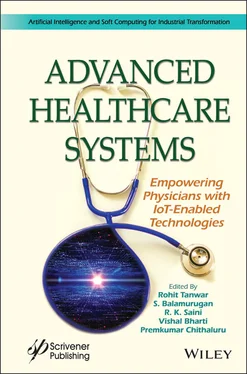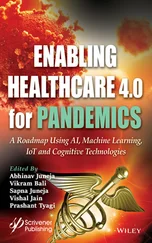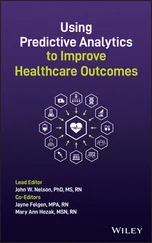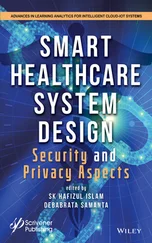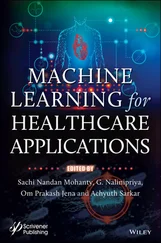Advanced Healthcare Systems
Здесь есть возможность читать онлайн «Advanced Healthcare Systems» — ознакомительный отрывок электронной книги совершенно бесплатно, а после прочтения отрывка купить полную версию. В некоторых случаях можно слушать аудио, скачать через торрент в формате fb2 и присутствует краткое содержание. Жанр: unrecognised, на английском языке. Описание произведения, (предисловие) а так же отзывы посетителей доступны на портале библиотеки ЛибКат.
- Название:Advanced Healthcare Systems
- Автор:
- Жанр:
- Год:неизвестен
- ISBN:нет данных
- Рейтинг книги:5 / 5. Голосов: 1
-
Избранное:Добавить в избранное
- Отзывы:
-
Ваша оценка:
- 100
- 1
- 2
- 3
- 4
- 5
Advanced Healthcare Systems: краткое содержание, описание и аннотация
Предлагаем к чтению аннотацию, описание, краткое содержание или предисловие (зависит от того, что написал сам автор книги «Advanced Healthcare Systems»). Если вы не нашли необходимую информацию о книге — напишите в комментариях, мы постараемся отыскать её.
This book offers a complete package involving the incubation of machine learning, AI, and IoT in healthcare that is beneficial for researchers, healthcare professionals, scientists, and technologists.
Audience
Advanced Healthcare Systems — читать онлайн ознакомительный отрывок
Ниже представлен текст книги, разбитый по страницам. Система сохранения места последней прочитанной страницы, позволяет с удобством читать онлайн бесплатно книгу «Advanced Healthcare Systems», без необходимости каждый раз заново искать на чём Вы остановились. Поставьте закладку, и сможете в любой момент перейти на страницу, на которой закончили чтение.
Интервал:
Закладка:
Though few aspects are non-replaceable by any form technology, still, digital interventions have penetrated in almost every component of all industries. Like in cases of libraries where, conventionally, these are in physical form of services and infrastructure, but it is now replaced with digital data storage and sharing to remotely access the intellectual content by anyone, anytime [4].
Healthcare has been traditionally more popular in its physical form of interaction between patient and nurses, pathologist, pharmacist, or clinicians. Hence, the emerging technology is transforming lives by replacing the human touch in partial mode in banking and financial markets, retail shopping, education, security systems, and many other sectors. Healthcare sector has seen massive change by reducing the number of visits to the hospital due to technological developments [5, 6]. In true sense, the leverage for power of IoT is to eliminate the burden of healthcare sector by enabling patients to connect with the medical facility providers by transferring their data in a secured embedded system.
The internet has been rebranded and is now referred to as “the cloud”. The IoT device requires a unique identification enabled by the RFID. Device has sensors for monitoring various parameters and can send the data through a wired or wireless communication to the cloud where this data is stored and can be converted into information. The procession of the enormous amount of data continuously generated (Big Data) requires immense computing power which is available in the cloud servers.
Now, with technological advancements, the medical devices are enabled to collect, analyze, and send data across the web using these advancements. They can now connect both digital and non-digital heart monitor like the heart monitor with patient beds directly to internet. Internet of Medical Things (IoMT) is going to bring a paradigm shift and will alter the future of healthcare by providing smart digital solutions with ease, comfort, availability, and accessibility of quality healthcare anywhere, anytime.
Most of the healthcare professionals and hospitals are now using IoT devices to optimally use their resources. Almost 70% of such hospitals and organizations use patient monitoring and maintenance of patient records. Patient data record is to be kept safely but industry is not tamper-proof, and hence, data leakage is still an issue in case of IoT. But still, in IoMT, there is an upper hand in as it has smart solutions which include endpoint security, internal segmentation, standard policies, and practices to authenticate end users and real-time monitoring which safety measures to prevent data breaches.
1.2.1 IoT and IoMT—Market Size
With half of the IoT market, IoMT constitutes the largest part IoT market. In 2017, IoT market was at $41 billion and expected to increase to $158 billion in 2022 with connected medical devices contributing to one-third of the market by 2022 [7]. The statistics indicate the gradual penetration of IoT technology. Almost 7 billion IoT devices were there in 2018, and in 2019, it jumped to 26.66 billion active IoT devices. Every second, 127 new IoT devices are connected to web, and by end of 2021, there will be almost 35 billion IoT devices installed worldwide. In terms of revenue generation for IoT market, the global spending on IoT in 2016 was $737 billion, and by 2021, it is expected to reach $124 billion, and only by 2026, it will reach $1.1 trillion. This indicates the enormity of IoT markets as global IoT healthcare market should reach 14 billion USD by 2024 [8].
Electronic patient records and patient monitoring are the largest usage of IoT in the present situation. Security in usage of IoMT is a major challenge. IoMT has improved the efficiency of healthcare delivery while lowering the cost of delivery per patient along with rapid implementation, thereby saving time and further lowering costs. The major challenge in IoMT is non-standardization of devices being in various platforms and inability for devices of one manufacturer to communicate with software or hardware of another. Multiple platform results in inefficiency. New devices and software need capital in terms of development and Food and Drug Administration (FDA) approval. Data privacy and security are factors that are to be kept in mind during its development and implementation. But implementation of IoMT increases cost of healthcare for devices, apps, cloud storage, and security. Data bandwidth required for the Big Data generated continuously by IoMT devices strains internet networks.
1.3 Smart Wearable Technology
The on-body segment or smart wearables can be broadly divided into consumer health wearables and medical- or clinical-grade wearables. Medicalgrade smart wearables are high quality and are FDA approved for use in hospital or home use. But recently, high-grade consumer wearables have taken on the quality of medical-grade wearables and have been validated in studies to be useful.
1.3.1 Consumer Fitness Smart Wearables
The most popular ones are wearable devices which are also called as lifestyle devices which include activity trackers like bands, wristwatches, chest strap, and shoes. These devices are worn by patients as well as healthy people who are fitness conscious. Such devices have sensors that regularly monitor, record, and collect data based on the health parameters based on physical activities.
Consumer smart wearables generate data which can help provide feedback to the individual regarding his/her health and thereby modify their lifestyle accordingly. But these devices are plagued with issues of reliability, safety, and security of this data [9]. A 2017 study by Apple and Standford University in 400,000 users of Apple watch series 1, 2, and 3 and its mobile app used data generated by the pulse sensors to identify hearth rhythm abnormality called atrial fibrillation. Atrial fibrillation is an irregularity of the heart beat with the pulse generated described as irregularly irregular. This can initially be intermittent with intervening normal heart rhythm or become chronic with continuous AF. The results of this study showed that 0.5% of the subjects received a notification of an irregular pulse. These subjects were sent a telemetry ECG patch to directly detect and monitor the electrical activity of the heart. Results showed that that the Apple watch diagnosed an episode of AF correctly 84% of the time and one-third were diagnosed with AF by the ECG patch. In addition, 57% of those who received an AF notification by the mobile app consulted a doctor. The Apple Heart Study shows that consumer wearable technology can help in detecting serious medical conditions like atrial fibrillation [10]. Consumer smart wearables can sense and continuously record some vital bodily functions and therefore provide feedback regarding health and help in modifying behaviour and lifestyle [11]. But more than half of the technology used in consumer smart wearables has not been certified or validated independently. Only 1 in 10 technologies has been validated with clinical research. Therefore, quality of data smart consumer wearables is debatable and interpretation of such data is questionable [12]. In contrast, clinical- or medical-grade wearables are approved or certified by health regulatory authorities like the FDA and are used with the advice of healthcare professionals or on prescription of a doctor. Accuracy of these devices can enable diagnosis and management of diseases.
1.3.2 Clinical-Grade Wearables
Medical-grade or clinical-grade wearables are those certified by the regulatory authorities like FDA for use by healthcare professionals. They can be used at home or in a clinic or hospital and expected to improve quality of life in chronic diseases and reduce the cost of long-term care.
Читать дальшеИнтервал:
Закладка:
Похожие книги на «Advanced Healthcare Systems»
Представляем Вашему вниманию похожие книги на «Advanced Healthcare Systems» списком для выбора. Мы отобрали схожую по названию и смыслу литературу в надежде предоставить читателям больше вариантов отыскать новые, интересные, ещё непрочитанные произведения.
Обсуждение, отзывы о книге «Advanced Healthcare Systems» и просто собственные мнения читателей. Оставьте ваши комментарии, напишите, что Вы думаете о произведении, его смысле или главных героях. Укажите что конкретно понравилось, а что нет, и почему Вы так считаете.
